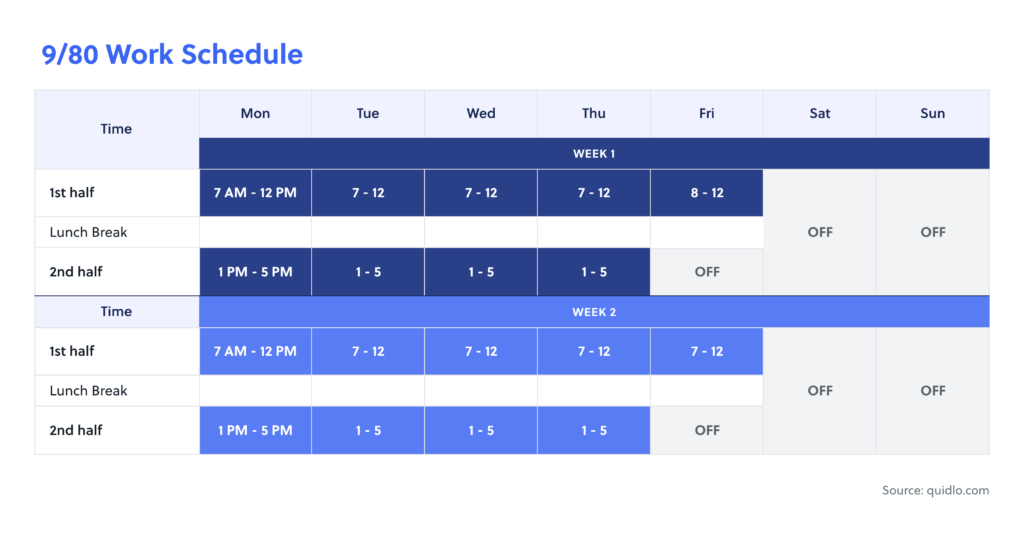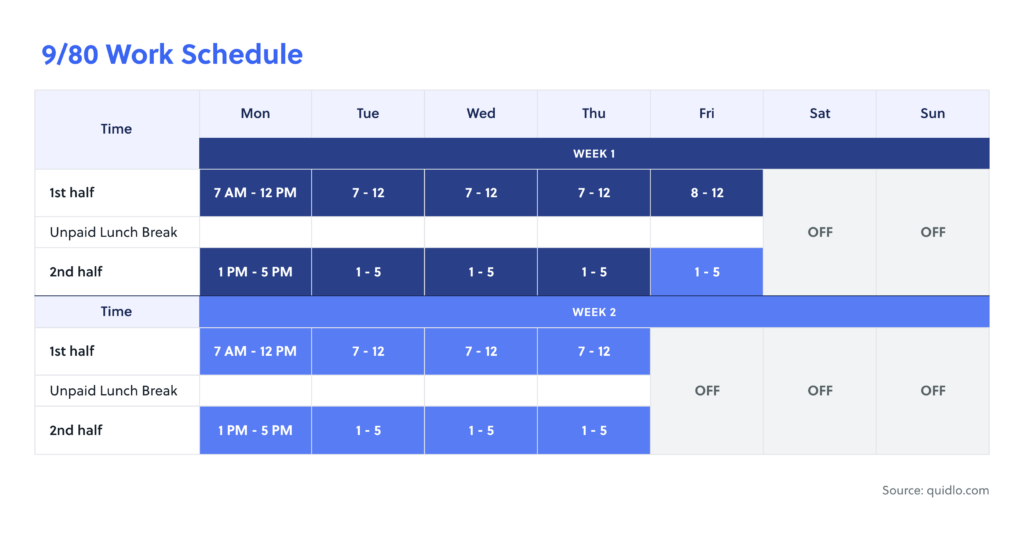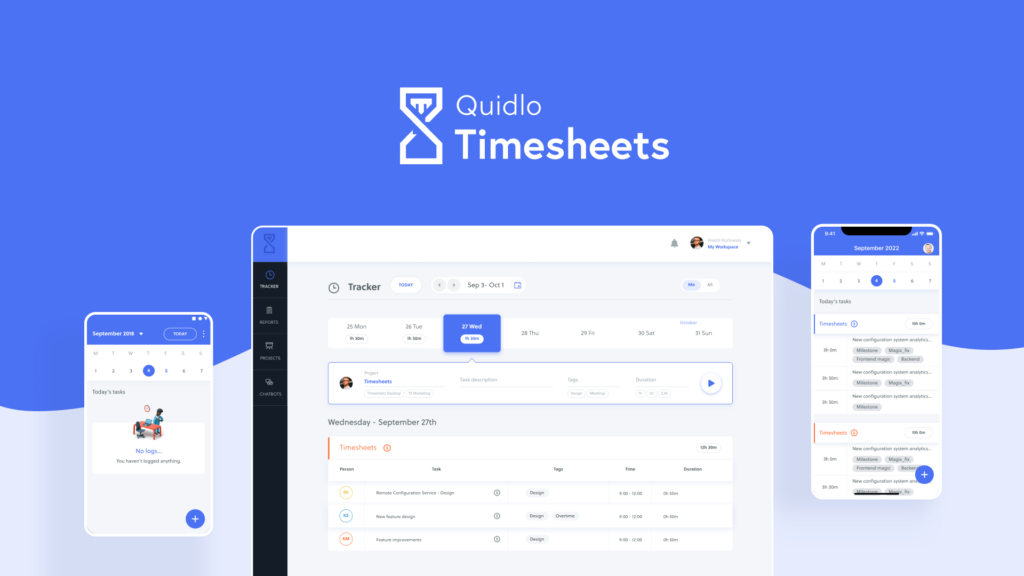Everyone knows about the 40-hour workweek. But have you heard of the 9/80 arrangement?
Lots of companies prefer this compressed workweek system – and the employees seem to love it too. But is implementing a 9/80 work schedule the right decision for your business and employee morale?
What is it, even? How does it work? Pros and cons?
At Quidlo, we’re going to cover everything you need to know about these so-called 9-hour days and how they may (or may not) benefit your company and work-life balance.
Ready? Let’s go.
Table of Contents
What is a 9/80 Work Schedule?
A 9/80 work schedule is a system where employees work 80 hours over nine days (hence, the name) instead of the usual 10 (assuming a five-day workweek). This would require your staff to work a total of eight nine-hour days, one eight-hour day, and have one day off over a two-workweek period. The extra day off is usually either every other week or every week.
The goal of this arrangement is to give employees more time to rest and relax while still maintaining the productivity levels of a five-day workweek.
👉 Recommended article: The 4/10 Work Schedule Guide
How Does a 9/80 Schedule Work?
As mentioned earlier, employees working a 9/80 schedule earn one day off after nine eight-hour days and one eight-hour day within two-week periods. But, management can arrange the hours so that employees either have a full day off every other week or have a four-hour day every week.
Usually, organizations that follow this scheduling system divide a week into four nine-hour days and one four-hour day. And in the second week, it’s the same with another four-hour day to add up to a full eight-hour workday. When it comes to payroll, employers also divide the day into two parts: the first four hours pertain to the first week, and the second four hours are clocked during the second week.
Here are two examples of how to implement a 9/80 work schedule:
Sample 9/80 Work Schedule – Variant 1

Week 1
Monday: 7 AM – 12 PM and 1 PM -5 PM with a lunch break in-between (9 hours total)
Tuesday & Wednesday: Same
Thursday: Same (for a total of 36 hours)
Friday: 8-12 (the first week ends)
Saturday & Sunday: Off
Week 2 (repeat)
Monday: 7 AM – 12 PM and 1 PM -5 PM with a lunch break in-between (9 hours total)
Tuesday & Wednesday: Same
Thursday: Same (for a total of 36 hours)
Friday: 8-12 (the first week ends)
Saturday & Sunday: Off
Sample 9/80 Work Schedule – Variant 2

Week 1
Monday: 7-12 and 1-5 with an unpaid lunch break in-between (9 hours total)
Tuesday & Wednesday: Same
Thursday: Same (for a total of 36 hours)
Friday: 8-12 (first week ends) + 1-5 (second week starts)
Saturday & Sunday: Off
Week 2
Monday: 7-12 and 1-5 with an unpaid lunch break in between (9 hours total)
Tuesday & Wednesday: Same
Thursday: Same (for a total of 40 hours including the four hours worked the previous Friday)
Friday: Off (extra day off)
Saturday & Sunday: Off
Advantages of a 9/80 Work Schedule
So you might be wondering: what’s the point in switching from the 8-hour days to the 9/80 work schedule? Let’s take a look at what’s in it for the employee and employer:
Employee Advantages of a 9/80 Work Schedule
- Work/life balance: With a guaranteed two extra days off each month, employees can enjoy more time outside of work. They can use that time to take care of errands, spend time with family and friends, or just relax.
- Fewer interruptions in their day-to-day: Employees will have more time to attend personal commitments during downtime so they can be more productive and engaged at work.
- Better commuting: With more days off, workers will have to travel less so they can save on gas. And the days they do come to work, they can avoid busy traffic with the custom schedule.
Employer Advantages of a 9/80 Work Schedule
- More employee productivity: By having more rested and focused employees from the well-earned day-off, businesses can enjoy improved morale, see fewer sick days and vacation requests, and better task completion on the working days.
- Reduced need for office space: With one extra day off each week, there will be less people in the office so companies can save on workplace costs.
- Attracts top talent: Companies that offer a 9/80 work schedule often have an easier time recruiting the best and brightest employees because of its appeal.
- Flexibility: Employers can adjust the days and hours worked to better suit the needs of their business. For example, if a business feels like they can’t afford an extra day-off, they can give half the team Friday off and the other half gets Monday off. By splitting the day off incentive between two teams, everyone gets a three-day weekend while the business remains open all week.
Disadvantages of a 9/80 Work Schedule
While the 9/80 work schedule arrangement has its perks, there are some disadvantages that employees and businesses should be aware of:
Employee Disadvantages of a 9/80 Work Schedule
- Longer workdays: Working nine hours a day instead of eight can take a toll on an employee’s mental stamina during workdays. They may feel like they only have time left to commute home, eat dinner, and go to sleep. That could wear on their morale over time.
- Problems with focus: Some people may have a harder time focusing for such long days. And for those who prefer a quiet environment, too much activity can distract employees and make them fall behind on work – which adds stress.
- Childcare: If an employee has young children, they may need to find childcare for the longer days or even make some less-than-ideal sacrifices. This could become costly if they’re using a professional service and have a negative impact on their relationships with children.
Employer Disadvantages of a 9/80 Work Schedule
- Potential abuse and overtime: The 9/80 work schedule can lend itself to abuse. Some employees may start another project or task with the extra hour but fail to finish it, going overtime. This can cut into a company’s bottom line if it happens too frequently.
- Harder for small businesses to sustain: Small businesses are the backbone of the American economy, but they don’t always have the same resources as larger businesses. They may not have enough employees to adequately cover all their bases while still giving everyone a day off. This could lead to an overworked staff or lousy operations that reflect poorly on the company.
- Employees may have trouble adjusting (less productivity): Some employees work harder in the evening, while others are more productive in the morning. But adjusting their schedule for the additional hour of work could mean sacrifices elsewhere – like sleep, driving kids to school earlier (along with everything that comes along with it), or working when they’re not at their best.
- Not everyone gets the same days off: In order to make the 9/80 work schedule work, usually employees have to rotate their days off. So, one week an employee may have Monday and Tuesday off, but the next week they may have Thursday and Friday off. While this is fair, it can be disruptive to some employees’ lives.
9/80 Work Schedule from a Legal Perspective
The law dictates that employees can work up to 40 hours a week. Whether that’s met by an 8-hour day, 5 days a week or 9/80 arrangement is up to the business. However, it’s important to note that the FLSA (Fair Labor Standards Act) requires employees to be paid time-and-a-half (1.5x) for any hours worked over 40 in a week.
9/80 Work Schedule Payroll
When you have a 9/80 work schedule, employes might work 9 hours on one day and 8 hours on the next. Of course, they still get paid for 40 hours even if they’re working a little bit more on some days, since the overall hours still add up to 40. But if again, if they work more than 40 hours in a week, they must get paid time-and-a-half for those extra hours.
So, you’d have your employees work four nine-hour days (36 hours) followed by one eight-hour day. But for payroll purposes, you apply the first half of an eight-hour workday to the first week and the second half to the following week.
This amounts to 40 hours worked Monday through Friday of the first week, and 40 hours worked Monday through Thursday of the second week (all avoiding overtime pay). The second Friday can then be completely off without affecting work hours.
9/80 Work Schedule: Handling Overtime
Sometimes people who work a 9/80 work schedule may end up working more than 40 hours in a week. If this happens, they get paid time-and-a-half for the extra hours worked.
To avoid having to pay overtime, employers need to be very careful about how they schedule their employees’ work hours. They should keep track of the number of hours each employee works in a week and make sure that no one works more than 40 hours.
Pro tip: Use a simple timesheet app to easily track the total amount of time employees spend on a project and monitor their progress to stay on top of your overtime payment obligations. Quidlo lets you assign user roles and generate custom reports so there’s complete transparency, through and through.
If an employee does work overtime, the employer should calculate the overtime pay using the employee’s regular rate of pay. The regular rate of pay is the employee’s salary divided by the number of hours they are supposed to work in a week. So for instance, if an employee is paid a salary of $800 per week and they are supposed to work 40 hours, their regular rate of pay would be $20 per hour.
If an employee works 45 hours in a week, their overtime pay would be calculated as follows:
Regular rate of pay: $800 ÷ 40 = $20 per hour
Overtime rate of pay: $20 x 1.5 = $30 per hour
Overtime pay: $30 x 5 = $150
The employee would then be paid a total of $950 for the week ($800 + $150).
9/80 Work Schedule: Navigating Holidays, Sick-time, & Vacations
Managing holidays and sick time is pretty straightforward with the 9/80 work schedule.
The way holidays are handled on a 9/80 schedule depends on whether the holiday falls on an eight-hour or nine-hour workday. When it’s an eight-hour workday, employees usually get eight hours of holiday credit with a deadline. And if the holiday falls on a nine-hour day, employees get eight hours of holiday credit plus one hour of paid time off.
When it comes to sick time, it’s how many hours that were supposed to be worked on the day that was missed. When an employee misses a nine-hour day for illness, nine hours are deducted from their sick leave. Similarly, only eight hours are deducted if it was an eight-hour day.
As for vacation time, it’s accrued based on the number of hours worked per week. So, if an employee works 36 hours one week and 40 hours the next, they would accrue four hours of vacation time in the first week and eight hours in the second.
How Popular is a 9/80 Work Schedule?
Post-pandemic employees want more flexibility in their schedules and a better way to balance work and life. According to the EY 2021 Work Reimagined Employee Survey, over half of employees (54%) would leave if they didn’t have some flexibility in where and when they work.
A lot of employees experienced burnout from the standard 5-day/40-hour workweek, a poor work-life balance, and a dysfunctional work-life balance during the pandemic. So alternative work schedules are on the rise, like the 9/80.
Companies say it boosts employee motivation, productivity, and ensures engagement, generating greater value for businesses and providing greater flexibility for employees.
Examples of a 9/80 Work Schedule
To help you learn from real policies, we scoured the internet for companies using the 9-80 work week. Below you’ll find some companies using the 9-80 work schedule:
- Twitter – Ronnie Chen, Sr. Engineering Manager at Twitter, tweeted: “Twitter announced support for a 9/80 schedule (1 day off every other week) but none of my reports were comfortable taking it until we announced that myself & team leads would be taking it. If you’re a people manager, you have a responsibility to normalize actually using the perks.”
- BAE Systems – Employees at BAE Systems, a global defense and aerospace company, work 9-hour days for 9 days and get every other Friday off. It was introduced during the dot-com boom in 1996 in an effort to keep employees around.
- Chevron – As stated in their 2002 memorandum of agreement, the work week will be redefined with every other Friday as a non-work day to accommodate the ‘9/80’ schedule. On Friday, the work week starts after 4 hours (halfway through the day).
- Roth Staffing Companies – “The slam dunk is our flexible 9-80 schedule. The majority of our competitors average 12-13 hours per day. While they make a great living, they don’t have a great life without the balance.”
Is a 9/80 Work Schedule Good for Your Business? (3 things to consider)
Making the switch to a 9/80 schedule affects the whole company and can require significant organizational change. Here are some important points to consider.
What do your business operations look like?
Your industry and business model are huge factors when deciding if a 9/80 work schedule is a good idea. Before making any moves, ask yourself some important questions:
- How big is your staff?
- How many people do you need during the week?
- What responsibilities do your staff carry out?
Workforces best suited for the 9/80 schedule:
- Software developers
- Business consultants
- Graphic designers
- Accountants
- Online tutors
- Video editors
Why? It’s easier to implement the 9/80 schedule when staff can work the same hours and have the same day off every other week. This isn’t something that’s available to all industries. It usually applies to knowledge-based firms (as opposed to manual labor or service firms) where individual employee contributions determine the company’s output.
For these businesses, there’s little friction with operating nine days every two weeks instead of ten, so long as they schedule tasks and deadlines properly. Plus, a fixed day off for the entire workforce means the business can close entirely for a day – saving costs.
Industries where implementing a 9/80 schedule can prove difficult:
- Retail
- Hospitality
- Manufacturing
- Construction
- Logistics
Why? These businesses have customer-facing workforces that must be available at the standard opening and closing hours. The staff must fulfill physically demanding responsibilities and deliver time-sensitive deadlines throughout the week, making the 9/80 arrangement somewhat problematic.
It’s still possible, it just requires a significant amount of organization and coordination.
What do the staff say?
The 9/80 schedule is a big change for any company, and it’s important to ensure that your employees are on board. After all, they’re the ones who will be working the new hours.
You can start by surveying your staff to see how they feel about the possibility of a 9/80 work week.
- Do they want more time off?
- Do they feel overworked?
- What do they think about the company’s current work schedule?
If you find that your employees are receptive to the idea of a 9/80 work week, then it’s worth considering. But if they’re not interested or don’t think it would work for them, then it might not be the best solution for your company.
Remember that the switch to a 9/80 work schedule doesn’t have to be a company-wide thing. You could run some trials for specific departments or teams to test the waters. Often, you may find that employees who were hesitant at first are coming around after seeing their colleagues enjoy a three-day weekend.
Do you have the resources?
Making the switch to a 9/80 work schedule can be resource-intensive, and it’s important to make sure that you have the necessary tools and systems in place before making the change.
Ask yourself:
- Do we have enough employees and skillsets to ensure the shift coverage matches demand?
- Can we support the organizational demands for transitioning employees to the new schedule (e.g, training, communications, etc.)
- Is our payroll system prepared to adapt to this new work schedule? (Otherwise, you might find your bottom line suffering from excessive overtime compensation)
- Is the HR department prepared to handle sick pay and holiday/vacation time?
If you answered ‘no’ to any of these questions, then it might not be the right time (yet) to implement a 9/80 work schedule.
That said, if you’re confident that you have the resources in place to make the switch, then it could be a great way to improve employee productivity and satisfaction – leading to better business outcomes.
How to Implement a 9/80 Work Schedule in Your Organization: The Step-by-step
If you’ve decided that a 9/80 work schedule is right for your organization, then it’s time to start planning the transition. Here’s a step-by-step guide to help you make the switch:
1. Communicate the decision to employees
The first step is to let your employees know about the decision to switch to a 9/80 work schedule. This is important for two reasons: first, because they need to be prepared for the change; and second, because you want to make sure they’re on board with the idea. The last thing you want is for your employees to be blindsided by the change.
2. Train managers
Once you’ve communicated the decision to employees, it’s time to start training managers on how to implement the 9/80 work schedule. This includes things like creating work schedules, managing time off requests, and dealing with employees who call in sick.
3. Confirm team availability
One of the challenges of a 9/80 work schedule is making sure that you have enough employees available to cover all the shifts. This is why it’s important to confirm team availability before finalizing the schedule.
4. Test the work schedule
The next step is to create the actual work schedule and have employees try it out for themselves. This will give you a chance to see if there are any problems with the schedule, and it will also help employees get used to the new schedule. If you’re looking for a 9/80 work schedule template, scroll up to the previous section where we’ve provided you with two actionable examples.
5. Evaluate the results
Look into employee satisfaction, productivity, and absenteeism. If you’re happy with the results, then you can implement the 9/80 work schedule on a permanent basis. If not, then you can make adjustments to the schedule until you find something that works for your organization.
Extra Tips for Implementing a 9/80 Work Schedule
Here are a few tips to help you implement a 9/80 work schedule in your organization:
- Be flexible: One of the benefits of a 9/80 work schedule is that it’s flexible. This means that you can adjust the schedule to meet the needs of your employees and your business. For example, if you have an employee who needs to leave early for child care, you can adjust their schedule so that they work 9 hours on 4 days of the week instead of 8 hours on 5 days.
- Communicate with employees: As we mentioned before, it’s important to communicate with employees about the transition to a 9/80 work schedule. This includes letting them know about the decision, explaining the benefits of the schedule, and answering any questions they might have.
- Plan ahead: Another important tip is to plan ahead. This includes things like creating a work schedule that meets the needs of your business and having a system in place for dealing with employees who call in sick.
- Be patient: Finally, it’s important to be patient. Implementing a 9/80 work schedule is a big change, and it will take some time for employees to get used to the new schedule. So be patient and give them time to adjust.
Use Quidlo to track if the 9/80 is working in your company
The 9/80 work schedule is a great way of working that allows employees to have nine hours of work each day, spread out over four days. This leaves them with three days off each week, which can be used for rest, recreation, or to take care of personal business. The switch can lead to increased productivity and reduced absenteeism.

If you’re thinking of implementing a 9/80 work schedule in your organization, it can be worthwhile using a time tracker app like Quidlo to monitor how your employees spend their time at work to see if you’re actually getting more out of this new arrangement. You can sign up for a free 30-day trial (no credit card required) today.
The verdict?
There’s no easy answer when it comes to whether or not your company should switch to a 9/80 work schedule. It depends on a variety of factors, from the type of industry you’re in, to the resources you have available.
But if you’re considering making the switch, it’s important to do your research and consult with your employees before making a decision. After all, it’s their work week that will be changing – so you want to make sure they’re on board with the idea.







